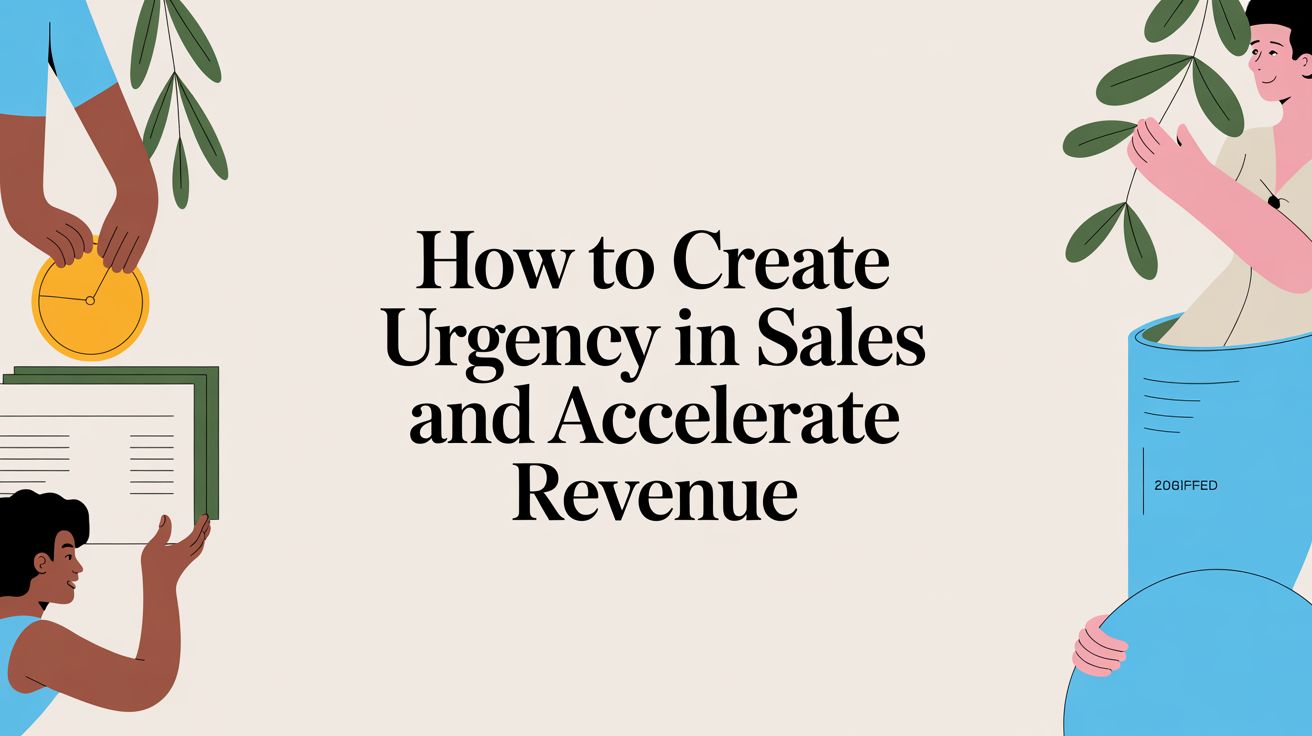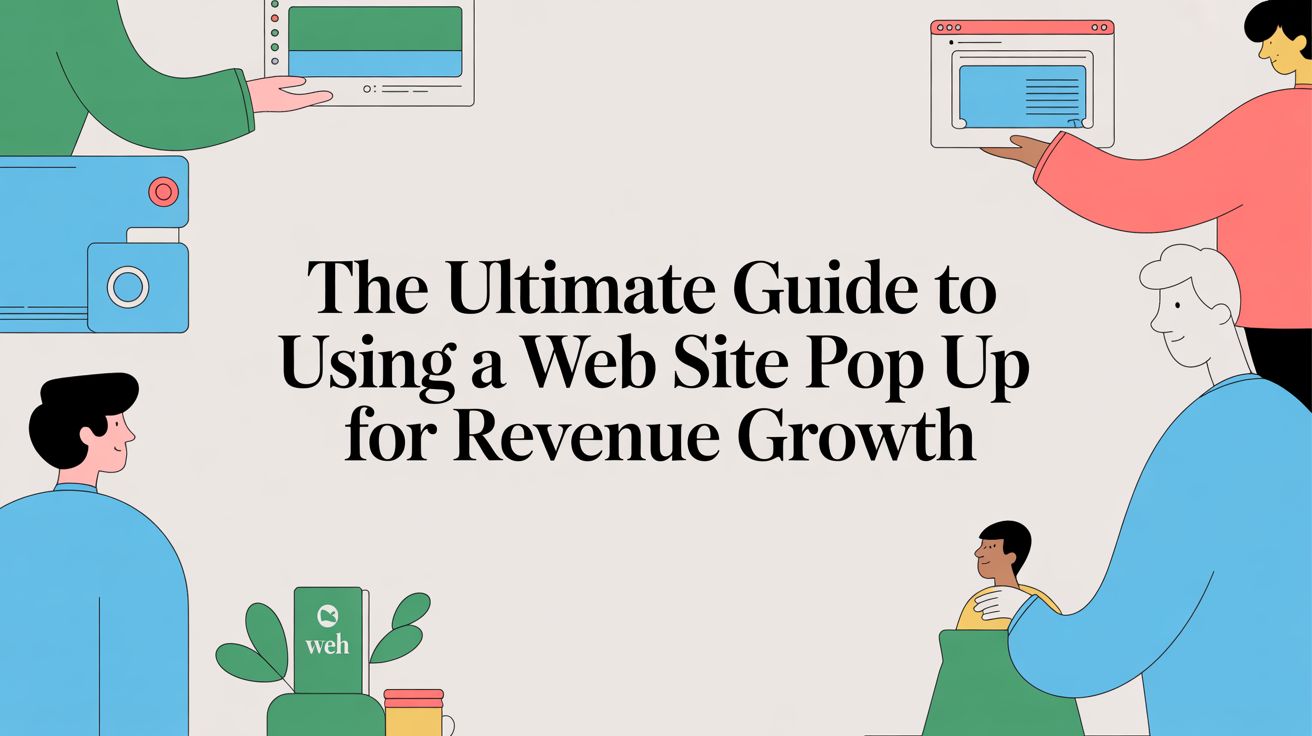
Abandoned Cart Email Example: 7 Templates Grounded in Psychology
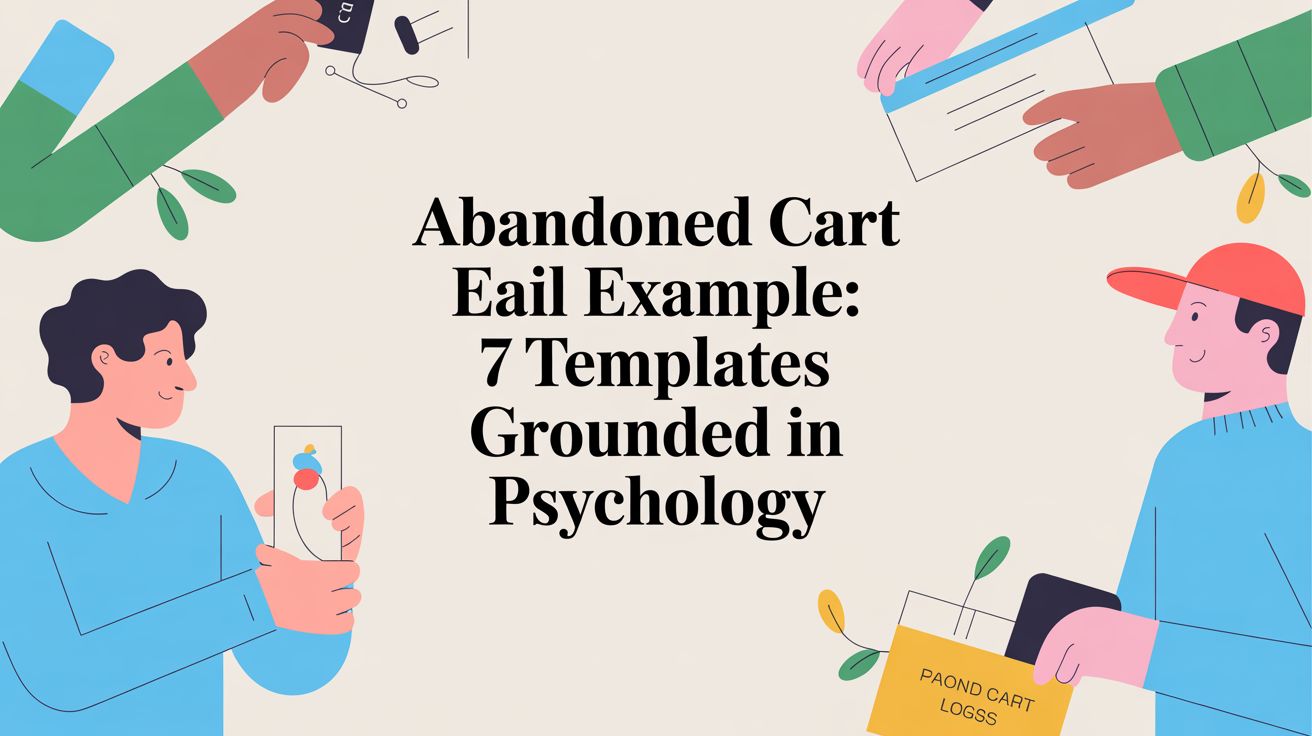
With the average cart abandonment rate hovering near 70% across e-commerce, brands are consistently leaving significant revenue on the table. This isn't just a lost sale; it's a critical gap in the customer journey where purchase intent disconnects from action. Standard recovery emails often fail because they overlook the complex consumer psychology behind this decision, from price sensitivity to simple distraction. This guide moves beyond generic reminders, providing a deep dive into seven psychologically-driven abandoned cart email example templates designed to drive ROI.
We will break down precisely why each example works, grounding our analysis in behavioral economics principles like loss aversion, social proof, and scarcity. You will learn not just what to send, but why it's effective. For merchants on platforms like Shopify, we provide actionable takeaways you can implement today, helping you integrate these strategies with tools like Klaviyo and various SMS platforms. The goal is to transform abandoned carts from a revenue leak into a powerful recovery channel. While these emails are crucial, for a deeper dive into the broader landscape of methods to recover lost sales, you can explore other powerful shopping cart abandonment solutions. Let's begin reclaiming that lost revenue.
1. The Simple Reminder Email
The Simple Reminder is the foundational abandoned cart email example for a reason: it's effective, easy to implement, and respects the customer’s journey. This initial touchpoint, typically sent 1-3 hours after a shopper leaves, acts as a gentle nudge rather than an aggressive sales pitch. Its primary goal is to bring the abandoned products back to the top of the customer's mind while their purchase intent is still high.
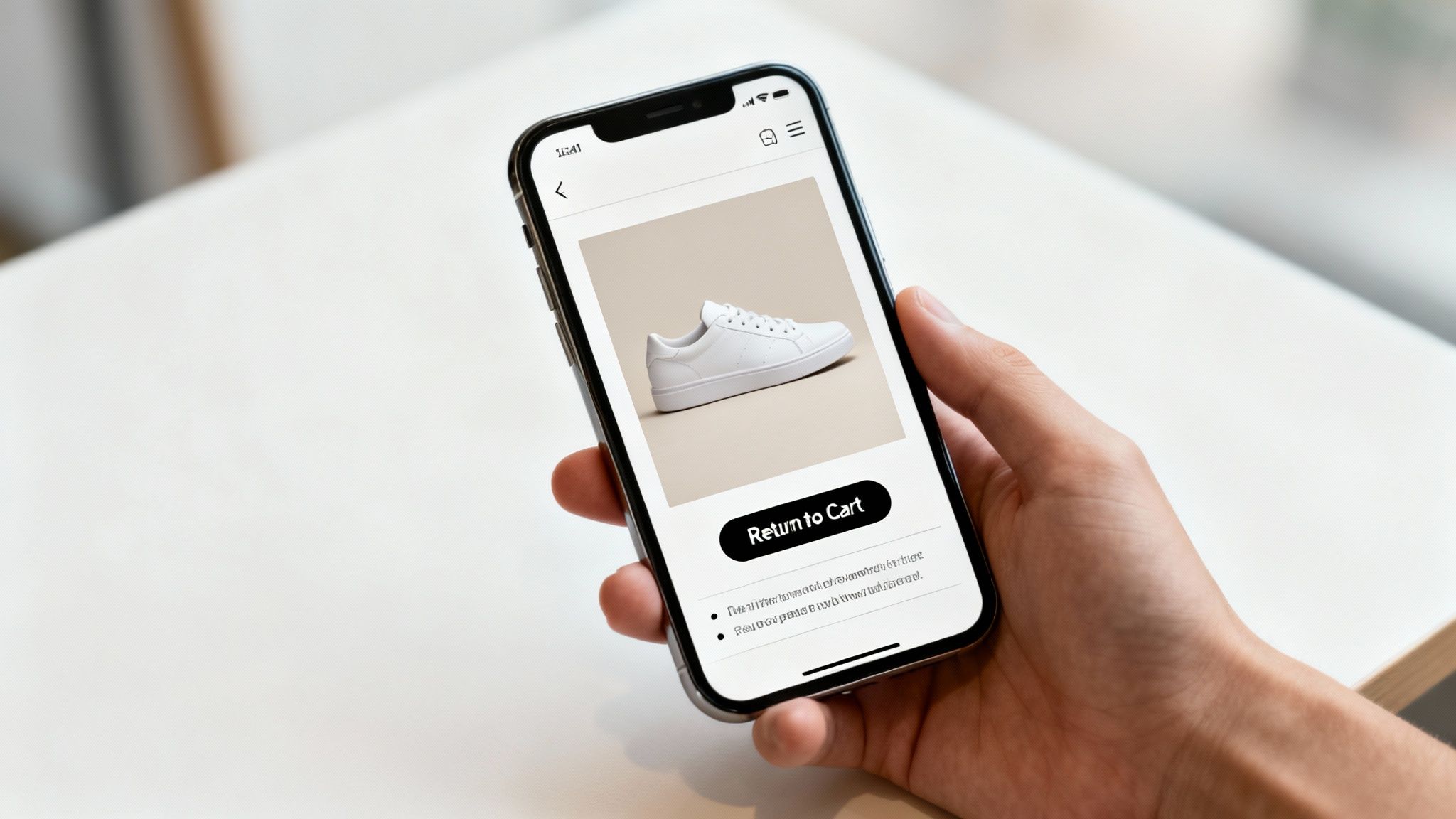
This strategy leverages the Zeigarnik effect, a psychological principle suggesting people better remember uncompleted tasks than completed ones. By simply showing the items left behind, you reactivate the customer's incomplete "task" of checking out, increasing the likelihood they will return to finish it.
Strategic Breakdown
Companies like ASOS and Warby Parker master this by combining a minimalist design with essential information. The focus remains squarely on the products the customer was already interested in.
- Clean Visuals: High-quality images of the cart items are the hero of the email.
- Minimal Copy: The messaging is direct and helpful, using phrases like "Still thinking it over?" or "Your cart is waiting."
- Clear Call-to-Action (CTA): A prominent button with action-oriented text like "Return to Your Cart" or "Complete Your Order" removes any friction.
Key Insight: The power of the simple reminder lies in its timing and subtlety. By arriving shortly after abandonment, it feels less like a marketing email and more like a helpful customer service follow-up, addressing potential distractions that pulled the shopper away.
How to Implement This Strategy
This first email in your abandoned cart sequence is crucial for recovering potentially lost revenue without resorting to discounts that can erode profit margins.
Actionable Takeaways:
- Set Up a 1-Hour Trigger: In your email platform (like Klaviyo or a native Shopify integration), create an automation flow that sends this email exactly 60 minutes after a cart is abandoned.
- Use a Direct Subject Line: Keep it under 50 characters. Test options like "Did you forget something?" or "Your [Brand Name] items are waiting."
- Show, Don't Just Tell: Dynamically pull in the specific product images, names, and prices from the customer's cart. This personal touch is far more effective than a generic message.
- Simplify the Path to Purchase: Ensure your CTA button links directly back to a pre-populated cart, minimizing the steps required for the customer to complete their purchase.
2. The Discount/Incentive Email
When a simple reminder isn't enough, the Discount/Incentive Email enters the sequence as a powerful persuasion tool. This abandoned cart email example directly addresses one of the most common reasons for abandonment: price sensitivity. By offering a compelling reason to buy now, such as a percentage discount or free shipping, you overcome a key purchase barrier and sweeten the deal for hesitant shoppers.
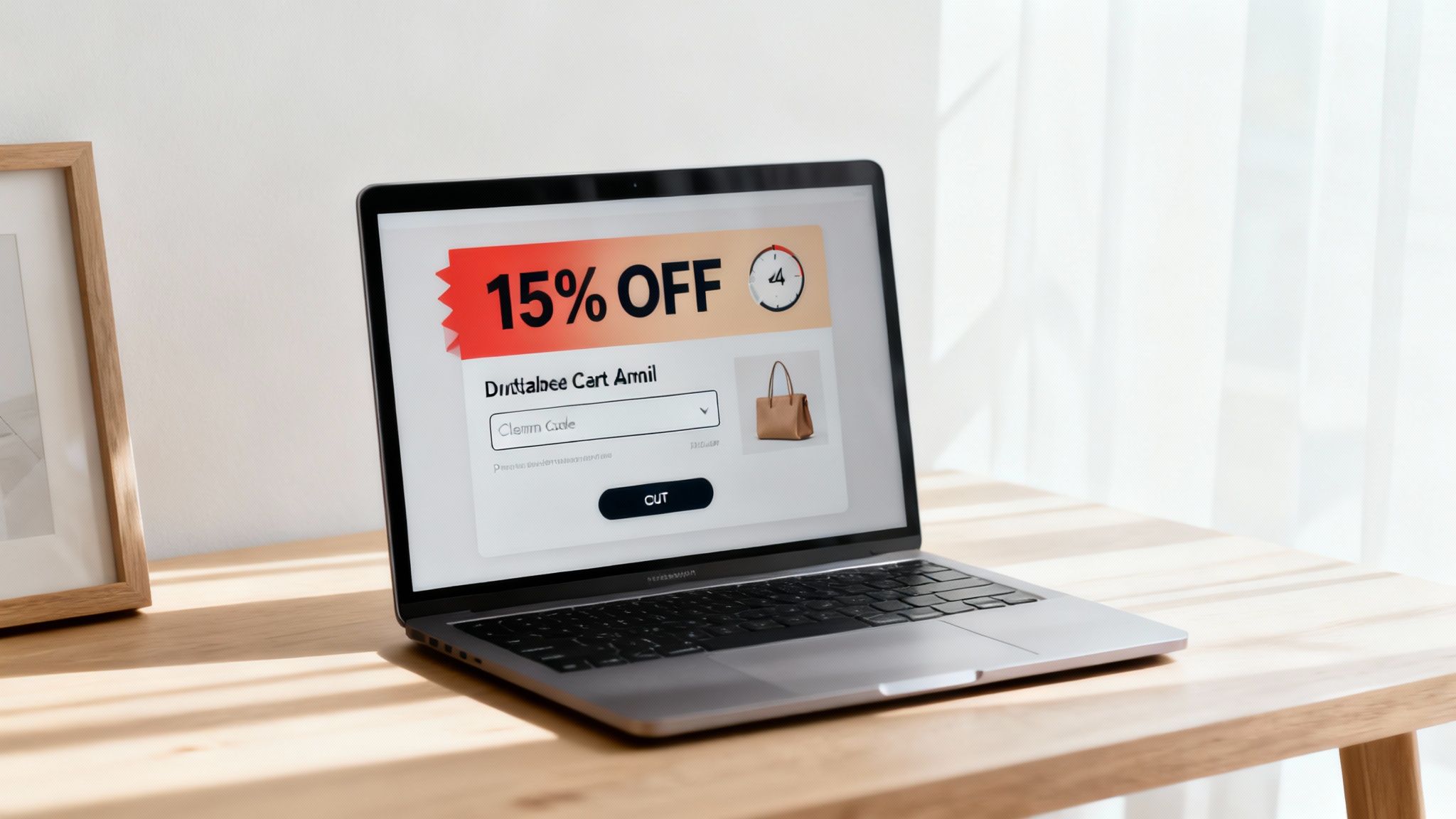
This strategy taps into the principle of reciprocity; by giving the customer something of value (a discount), they feel a psychological pull to reciprocate by completing the purchase. It also introduces a sense of urgency, especially when the offer is time-sensitive, leveraging Fear Of Missing Out (FOMO) to drive immediate action.
Strategic Breakdown
Brands like Chubbies and Fashion Nova have built entire recovery strategies around this model. They understand that a well-timed offer can convert a "maybe" into a definite "yes" by shifting the value equation in the customer's favor.
- Compelling Offer: The incentive is the star. Whether it's 15% off, free shipping, or a specific dollar amount off, the offer is clear and enticing.
- Urgency-Driven Copy: Phrases like "Don't Miss Out!" or "Your Discount Expires in 24 Hours" create a legitimate reason for the customer to act quickly.
- Personalized Codes: Using unique, one-time-use discount codes adds a layer of exclusivity and helps with tracking the true ROI of the campaign.
Key Insight: This email should be the second or third touchpoint, typically sent 24-48 hours after abandonment. Offering a discount too early trains customers to abandon carts intentionally, cannibalizing your profit margins. Its power lies in strategic deployment, not as a first resort.
How to Implement This Strategy
Deploying an incentive is about more than just slashing prices; it's a calculated move to recover high-intent shoppers who are on the fence. For a deeper understanding of what offers resonate most, it's helpful to research what consumers are looking for in an incentive.
Actionable Takeaways:
- Delay and Segment: Set your automation trigger for 24 hours post-abandonment. Crucially, create a segment that excludes customers who have already completed their purchase from the first reminder email.
- Create Urgency with an Expiration: Use a clear subject line like "A Special Offer Just For You" or "15% Off To Complete Your Order." In the email body, explicitly state that the offer expires in 24 or 48 hours.
- A/B Test Your Offers: Don't assume a percentage discount is always best. Test a 15% discount against a free shipping offer to see which one generates more recovered revenue for your specific audience and average order value.
- Protect Your Margins: In your email platform or Shopify settings, generate unique, single-use discount codes. Consider setting a minimum purchase value for the discount to apply, protecting profitability on smaller orders.
3. The Social Proof Email
The Social Proof Email addresses one of the biggest silent conversion killers: purchase anxiety. Sent as a second or third email in a sequence, this abandoned cart email example moves beyond a simple reminder and focuses on building trust. It reassures hesitant shoppers by showing them that other people have bought and loved the items in their cart, directly countering uncertainty about quality or fit.
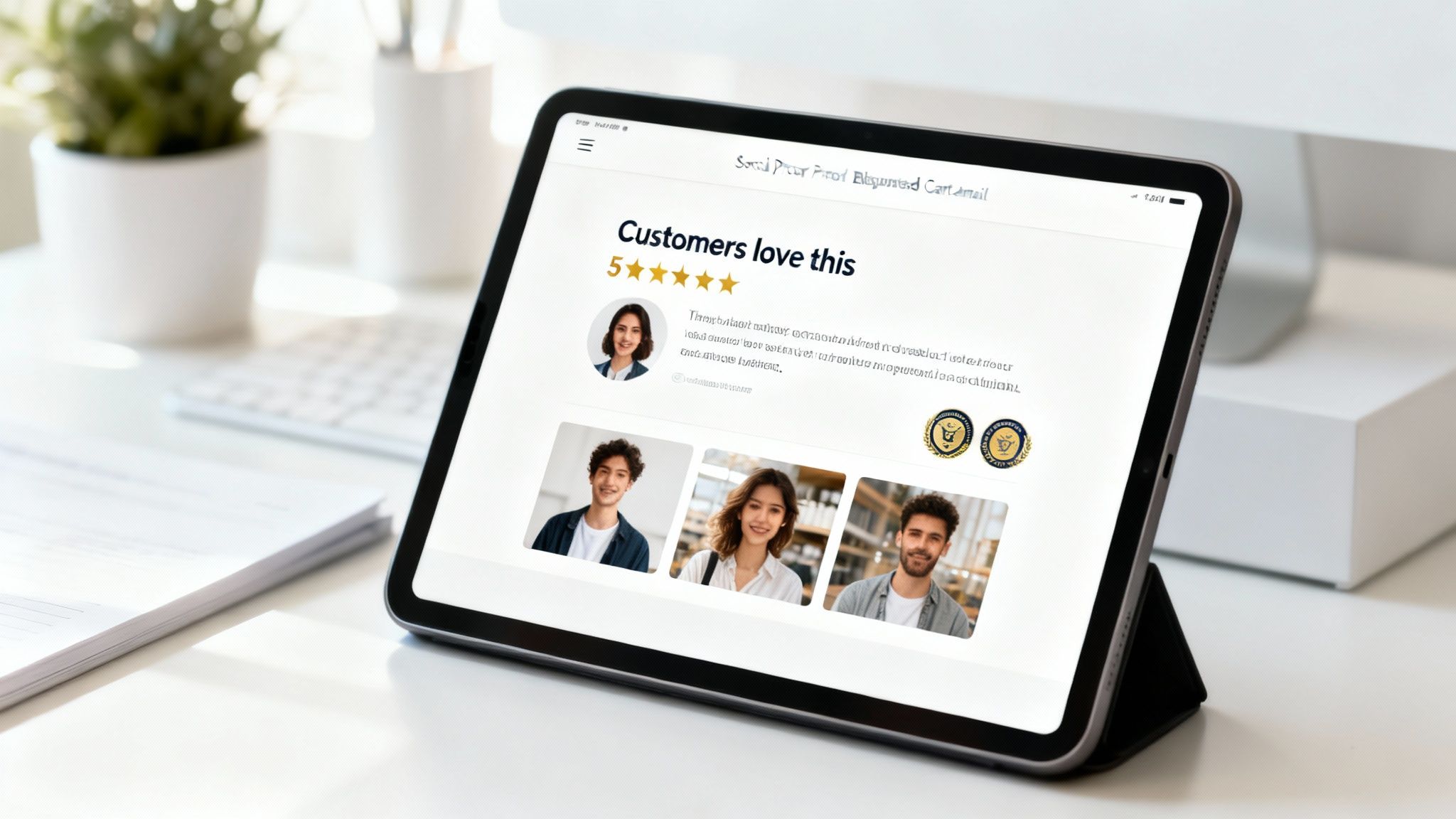
This tactic is rooted in the psychological principle of social proof, which states that people conform to the actions of others under the assumption that those actions reflect correct behavior. By showcasing reviews, ratings, and user-generated content, you reduce perceived risk and make the customer feel more confident in their decision to buy. If you want a deeper dive, you can learn more about the different types of social proof on hq.quikly.com.
Strategic Breakdown
Brands like Chewy and Glossier excel at this by integrating authentic customer feedback directly into their marketing. They don't just say their products are great; they let satisfied customers do the talking, which is far more persuasive.
- Product-Specific Reviews: The email dynamically pulls in star ratings and testimonials for the exact items the customer abandoned.
- User-Generated Content (UGC): Featuring real customer photos or Instagram posts creates an authentic, relatable connection.
- Popularity Indicators: Phrases like "Top Rated" or "Selling Fast!" signal that the product is in high demand, creating a sense of FOMO (Fear of Missing Out).
Key Insight: This strategy is most effective for new customers who have no prior experience with your brand or for higher-priced items where the investment feels riskier. Social proof acts as a powerful endorsement that bridges the trust gap.
How to Implement This Strategy
Integrating social proof requires a bit more technical setup than a simple reminder, but the impact on conversion rates, especially for considered purchases, can be substantial.
Actionable Takeaways:
- Integrate Your Review App: Connect your reviews platform (like Yotpo or Loox for Shopify) with your email service provider (like Klaviyo). This allows you to create automation rules that pull product-specific ratings into the email template.
- Craft a Trust-Building Subject Line: Go beyond "Your cart is expiring." Test subject lines like "See what others are saying about your items" or "Don't miss out on these 5-star favorites."
- Showcase Both Ratings and Testimonials: A high star rating provides a quick visual cue, while a short, compelling written review can address specific pain points or highlight key benefits.
- Add a Risk Reversal: Pair social proof with a mention of your return policy or a money-back guarantee. This combination creates a powerful, low-risk incentive to complete the purchase.
4. The Scarcity/Urgency Email
The Scarcity/Urgency Email transforms a simple reminder into a compelling call to action by introducing time-sensitive stakes. Sent 24-48 hours after abandonment, this abandoned cart email example leverages powerful psychological triggers like the fear of missing out (FOMO) and scarcity principles. Its goal is to motivate hesitant buyers to act quickly by highlighting limited stock, the item's popularity, or an expiring cart reservation.
This strategy is effective because it shifts the customer’s mindset from passive consideration to active decision-making. By showing that an item is in high demand or low supply, you reframe the purchase not just as a desire, but as an opportunity that could be lost, increasing its perceived value based on the principles of behavioral economics. This is a far more sophisticated approach than a basic countdown timer which often lacks credibility.
Strategic Breakdown
Companies like Nike, with its limited sneaker drops, and booking sites like Booking.com have perfected this approach. They create an environment where quick action is necessary to secure a desired product or deal, making the decision to complete the purchase feel more critical.
- Explicit Urgency Triggers: Use direct, data-backed copy such as "Only 3 left in stock" or "Selling fast."
- Social Proof Integration: Incorporate phrases like "15 other people are looking at this item" to reinforce demand.
- Clear Deadlines: Implement a real deadline when the cart or offer expires, rather than just a generic timer.
Key Insight: The effectiveness of urgency hinges on authenticity. Using genuine inventory data or real-time demand signals builds trust and makes the message potent. False scarcity can damage brand credibility and alienate customers permanently.
How to Implement This Strategy
This email works best as the second or third touchpoint in your sequence, after a simple reminder has been sent. It’s a powerful tool for converting shoppers who are on the fence but need a final push.
Actionable Takeaways:
- Use Real-Time Inventory Data: Integrate your email platform with your Shopify inventory to automatically trigger this email only when an abandoned item’s stock level drops below a set threshold (e.g., less than 5 units).
- Craft a Direct, Action-Oriented Subject Line: Try "Your items are selling out!" or "Last chance: Complete your order before it's gone."
- Incorporate Dynamic Content: Display specific numbers ("Only 2 left!") or use visual cues like a low-stock warning next to the product image. This specificity is far more persuasive than vague terms like "low stock."
- Balance Urgency with Brand Voice: Ensure your messaging creates excitement, not anxiety. For a deeper dive, you can learn more about implementing Shopify urgency tactics to enhance the customer journey without being overly aggressive.
5. The Personalized/Dynamic Content Email
This sophisticated abandoned cart email example moves beyond generic reminders by leveraging customer data to create a truly one-to-one experience. It dynamically populates content based on a shopper's browsing behavior, purchase history, and even expressed preferences. The goal is to make the email feel less like a mass-market broadcast and more like a personal consultation from a brand that genuinely understands the customer's needs.
This strategy taps into the "cocktail party effect," a psychological phenomenon where people tune out surrounding noise to focus on information that is personally relevant to them. By using a customer's name, referencing their past purchases, and suggesting products aligned with their unique taste, you cut through inbox clutter and command their attention, significantly increasing engagement and conversion.
Strategic Breakdown
Companies like Amazon and Sephora have perfected this approach, making it a cornerstone of their customer retention strategy. They transform a standard reminder into a compelling, relevant, and highly persuasive touchpoint that feels uniquely crafted for each recipient.
- Intelligent Recommendations: Instead of a simple "You left this behind," the email includes sections like "You might also like" or "Complete the look" with algorithmically chosen products.
- Segmented Messaging: The copy and offers can change based on customer segments, such as offering a small discount to a first-time shopper versus highlighting loyalty points for a repeat customer.
- Contextual Content: The email might reference previous purchases, like suggesting a conditioner that pairs perfectly with a shampoo the customer bought last month.
Key Insight: Personalization transforms an abandoned cart email from a transactional reminder into a relationship-building opportunity. It demonstrates that you are paying attention to individual customer preferences, fostering loyalty and driving higher lifetime value.
How to Implement This Strategy
Implementing dynamic content is crucial for standing out in a crowded market and showing customers you value them beyond a single transaction. This is an advanced tactic that can dramatically boost your recovery rates.
Actionable Takeaways:
- Leverage Your ESP's Power: Use an email service provider like Klaviyo or Omnisend that has robust dynamic content and product recommendation capabilities. Set up feeds that pull customer data and product catalogs in real-time.
- Start with Simple Personalization: Begin by adding the customer's first name to the subject line and body copy. For example: "Jenna, your Sephora cart is calling."
- Implement Dynamic Product Blocks: Create a "Recommended for You" section below the abandoned items. Configure your email platform to automatically suggest products based on the items in the cart or the customer's past browsing history.
- Segment and Tailor Offers: Create separate automation flows for different customer segments. For instance, high-value customers might see a message referencing their VIP status, while a new visitor could receive a message highlighting your brand's unique value proposition.
6. The Problem-Solving/Educational Email
Sometimes, a customer abandons a cart not due to distraction, but due to uncertainty. The Problem-Solving or Educational abandoned cart email example tackles this head-on by proactively addressing common questions and concerns that create friction in the buying process. This strategy shifts the focus from a direct sales push to providing genuine value and building customer confidence.
This approach leverages the principle of risk aversion. By answering questions about product fit, return policies, or complex features before the customer has to ask, you lower their perceived risk. This makes them feel more secure and informed, significantly increasing their likelihood of completing the purchase. It transforms the email from a simple reminder into a powerful piece of customer service.
Strategic Breakdown
Brands with complex or high-consideration products like Casper and ThirdLove excel with this strategy. They anticipate customer hesitation and provide detailed, reassuring information that guides the shopper toward a confident decision.
- Anticipatory Content: The email directly addresses common friction points like sizing, material, or return policies.
- Value-Driven Copy: The messaging is helpful and informative, using language like "Have questions? We have answers," or "Here's what you need to know."
- Multiple CTAs: Beyond a primary "Return to Cart" button, it may include secondary links to sizing guides, FAQs, or customer support.
Key Insight: This email builds trust and authority by demonstrating a deep understanding of the customer's needs. Instead of just asking for the sale, you're earning it by solving the problems that caused abandonment in the first place, effectively removing the final barriers to purchase.
How to Implement This Strategy
Use this email as the second or third touchpoint in your sequence, after a simple reminder has been sent. It’s ideal for products that require more education before purchase.
Actionable Takeaways:
- Identify Friction Points: Analyze your customer service tickets, live chat logs, and product reviews to find the most frequently asked questions for your key products. These are your content pillars.
- Use a Question-Based Subject Line: Spark curiosity with subject lines like "A few things you might be wondering" or "Your questions about [Product Name], answered."
- Structure for Scannability: Use clear headings, bullet points, and bold text to break down complex information. A customer trying to find sizing info should be able to spot it immediately.
- Embed Educational Content: Instead of just linking out, include key information directly in the email. For example, add a mini sizing guide, a short video explaining your product's technology, or highlight your "no-questions-asked" return policy.
7. The Multi-Email Sequence/Series
The Multi-Email Sequence is not a single email, but a strategic campaign designed to win back customers over several days. This advanced abandoned cart email example recognizes that a one-size-fits-all message often fails. Instead, it deploys a series of 3-5 automated emails, each with a unique angle, to address different barriers to purchase. The sequence escalates in persuasion, moving from a gentle reminder to value-driven content and finally to a compelling, time-sensitive offer.
This strategy works because it methodically overcomes a variety of customer hesitations. While the first email might solve for simple distraction, subsequent emails can tackle price sensitivity with a discount or build trust by highlighting social proof and product benefits. By varying the message, you create multiple opportunities to resonate with the shopper's specific, unresolved motivation for abandoning their cart.
Strategic Breakdown
Brands like Bombas and Dollar Shave Club excel at this by crafting a narrative over multiple touchpoints. Their sequences don't just repeat the same offer; they tell a story that builds value and urgency, guiding the customer back to purchase.
- Progressive Persuasion: The sequence starts soft (e.g., "Did you forget something?") and gradually introduces stronger motivators like social proof ("See what others are saying") or scarcity ("Limited stock remaining").
- Varied Content Angles: Each email serves a different purpose. Email one is a reminder, email two might educate on product features or the brand's social mission, and email three could introduce an incentive.
- Intelligent Timing: The cadence is crucial. A common, effective schedule is 1 hour, 24 hours, and then 72 hours, which maintains momentum without overwhelming the customer.
Key Insight: The power of a sequence lies in its adaptability. By building a multi-step flow, you create a safety net that catches different types of abandoners for different reasons, significantly increasing your overall recovery rate compared to a single-email approach.
How to Implement This Strategy
A well-planned sequence is one of the highest-ROI automations you can build, systematically converting hesitant shoppers into loyal customers.
Actionable Takeaways:
- Map Your Sequence Logic: In your email platform like Klaviyo, plan a 3-email flow. Email 1 (1 hour): Simple reminder. Email 2 (24 hours): Add value with reviews or benefits. Email 3 (72 hours): Create urgency with a small discount or free shipping offer.
- Vary Your Subject Lines: Each email needs a distinct subject line to encourage opens. For example: "Your cart is waiting," then "Still thinking it over? See what others think," and finally "A special offer just for you."
- Set an Exit Condition: The most critical rule in your automation is to immediately remove a customer from the sequence once they make a purchase. This prevents sending an irrelevant and annoying sales email to a new customer.
- Reserve Discounts for the End: To protect profit margins, only introduce a discount in the final email of the series. This trains customers that incentives are a last resort, not a standard expectation.
7 Abandoned Cart Email Examples Compared
| Email Type | Implementation complexity | Resource requirements | Expected outcomes (avg. conversion) | Ideal use cases | Key advantages |
|---|---|---|---|---|---|
| The Simple Reminder Email | Low — basic template and timing | Minimal: product images, CTA, responsive design | Modest uplift (5–10%) | First touch; high purchase-intent customers; premium brands | Non-intrusive, quick to implement, preserves brand perception |
| The Discount/Incentive Email | Low–Medium — add promo logic and timing rules | Promo codes, tracking, possible margin planning | High when discounted (15–25%) | 2nd–3rd email for price-sensitive shoppers; competitive markets | Strong conversion driver for price barriers; measurable ROI |
| The Social Proof Email | Medium — content curation and layout | Reviews database, UGC assets, trust badges | Moderate (8–15%) | New customers, higher-priced items, brands building credibility | Builds trust without discounting; addresses quality concerns |
| The Scarcity/Urgency Email | Medium — real-time inventory or timers | Inventory integration, dynamic timers, accurate data | Moderate–High (12–20%) | Limited-stock items, flash sales, events, bookings | Drives immediate action via FOMO without reducing price |
| The Personalized/Dynamic Content Email | High — complex logic and data integration | CRM/CDP, recommendation engine, dynamic content tooling | High (20–35%) | Brands with rich customer data; subscription services; large catalogs | Highly relevant and engaging; improves ROI and retention |
| The Problem-Solving/Educational Email | Medium — content-heavy and targeted | Product guides, videos, FAQs, support resources | Moderate (10–18%) | Complex or technical products; fit/sizing purchases; new brands | Reduces objections, builds trust, educates for long-term value |
| The Multi-Email Sequence/Series | High — orchestration and conditional flows | Automation platform, conditional logic, varied content | Highest cumulative (25–40%) | All e‑commerce with automation; moderate-to-high consideration buys | Covers multiple objections, optimizes touchpoints, increases recovery rate |
From Abandonment to Revenue: Implementing Next-Generation Urgency
We've explored a comprehensive arsenal of abandoned cart email examples, moving from simple reminders to sophisticated, multi-touch sequences. Each template serves a distinct purpose, leveraging psychological triggers to re-engage shoppers who have shown clear purchase intent. From the gentle nudge of a product reminder to the powerful pull of a limited-time offer, the right email at the right time is a proven revenue recovery tool.
The common thread woven through the most effective examples is a deep understanding of consumer behavior. The strategic use of scarcity, the trust-building power of social proof, and the compelling logic of a well-timed incentive are not just marketing tactics; they are applications of behavioral science. Mastering these techniques transforms your abandoned cart strategy from a reactive measure into a proactive revenue engine that protects margins and improves inventory management.
Key Takeaways for Immediate Implementation
To turn these insights into action, focus on these core principles:
- Segment Your Audience: Don't send a generic "you forgot something" email to everyone. Segment users based on cart value, customer history, and items left behind. High-value carts might warrant a more significant discount, while first-time shoppers could benefit from an email highlighting your brand's unique value proposition.
- Embrace the Sequence: A single email is rarely enough. A strategic three-part sequence, as demonstrated, builds momentum. Start with a helpful reminder, escalate with a compelling incentive, and create final urgency with a last-chance notification. This layered approach addresses different stages of hesitation without overwhelming the consumer.
- Go Beyond Basic Timers: While a simple countdown can be effective, next-generation urgency is about creating genuine anticipation through advanced behavioral triggers. Instead of just showing a clock, build a narrative around scarcity. Is the item a limited edition? Is stock running low due to high demand? Grounding your urgency in a believable context is far more powerful. This is where you see the difference between a basic abandoned cart email example and a truly high-converting one.
The Future is Proactive, Not Reactive
Ultimately, the most advanced e-commerce strategy aims to prevent cart abandonment before it happens. The psychological principles that make these emails work can be integrated much earlier in the shopper's journey. Instead of only using urgency to recover a lost sale, you can use it to secure the initial conversion.
This involves moving beyond isolated email automation and creating a cohesive, site-wide urgency strategy. By deploying dynamic, psychology-driven experiences like limited-time product drops or tiered offers directly on your Shopify or Shopify Plus store, you build excitement and drive decisive action from the moment a user lands on your site. This proactive approach, grounded in the science of urgency marketing, not only boosts initial conversion rates but also protects profit margins by reducing reliance on post-abandonment discounts.
Ready to move beyond reactive email recovery and build a proactive urgency strategy? See how Quikly helps the world's leading brands deploy sophisticated, psychology-driven marketing 'Moments' that enhance banners, popups, and the entire shopper's journey to increase initial conversion and drive significant revenue lift. Explore Quikly to see next-generation urgency in action.

The Quikly Content Team brings together urgency marketing experts, consumer psychologists, and data analysts who've helped power promotional campaigns since 2012. Drawing from our platform's 70M+ consumer interactions and thousands of successful campaigns, we share evidence-based insights that help brands create promotions that convert.
